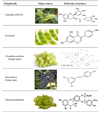Skin photoprotection by natural polyphenols: anti-inflammatory, antioxidant and DNA repair mechanisms
- PMID: 19898857
- PMCID: PMC2813915
- DOI: 10.1007/s00403-009-1001-3
Skin photoprotection by natural polyphenols: anti-inflammatory, antioxidant and DNA repair mechanisms
Abstract
Epidemiological, clinical and laboratory studies have implicated solar ultraviolet (UV) radiation in various skin diseases including, premature aging of the skin and melanoma and non-melanoma skin cancers. Chronic UV radiation exposure-induced skin diseases or skin disorders are caused by the excessive induction of inflammation, oxidative stress and DNA damage, etc. The use of chemopreventive agents, such as plant polyphenols, to inhibit these events in UV-exposed skin is gaining attention. Chemoprevention refers to the use of agents that can inhibit, reverse or retard the process of these harmful events in the UV-exposed skin. A wide variety of polyphenols or phytochemicals, most of which are dietary supplements, have been reported to possess substantial skin photoprotective effects. This review article summarizes the photoprotective effects of some selected polyphenols, such as green tea polyphenols, grape seed proanthocyanidins, resveratrol, silymarin and genistein, on UV-induced skin inflammation, oxidative stress and DNA damage, etc., with a focus on mechanisms underlying the photoprotective effects of these polyphenols. The laboratory studies conducted in animal models suggest that these polyphenols have the ability to protect the skin from the adverse effects of UV radiation, including the risk of skin cancers. It is suggested that polyphenols may favorably supplement sunscreens protection, and may be useful for skin diseases associated with solar UV radiation-induced inflammation, oxidative stress and DNA damage.
Figures
References
-
- Afaq F, Adhami VM, Ahmad N. Prevention of short-term ultraviolet B radiation-mediated damages by resveratrol in SKH-1 hairless mice. Toxicol Appl Pharmacol. 2003;186:28–37. - PubMed
-
- Aziz MH, Afaq F, Ahmad N. Prevention of ultraviolet B radiation - damage by resveratrol in mouse skin is mediated via modulation in Survivin. Photochem Photobiol. 2005;81:25–31. - PubMed
-
- Aziz MH, Kumar R, Ahmad N. Cancer chemoprevention by resveratrol: in vitro and in vivo studies and the underlying mechanisms (review) Int J Oncol. 2003;23:17–28. - PubMed
-
- Bachelor MA, Bowden GT. UVA-mediated activation of signaling pathways involved in skin tumor promotion and progression. Semin Cancer Biol. 2004;14:131–138. - PubMed
Publication types
MeSH terms
Substances
Grants and funding
LinkOut - more resources
Full Text Sources
Other Literature Sources
Medical


